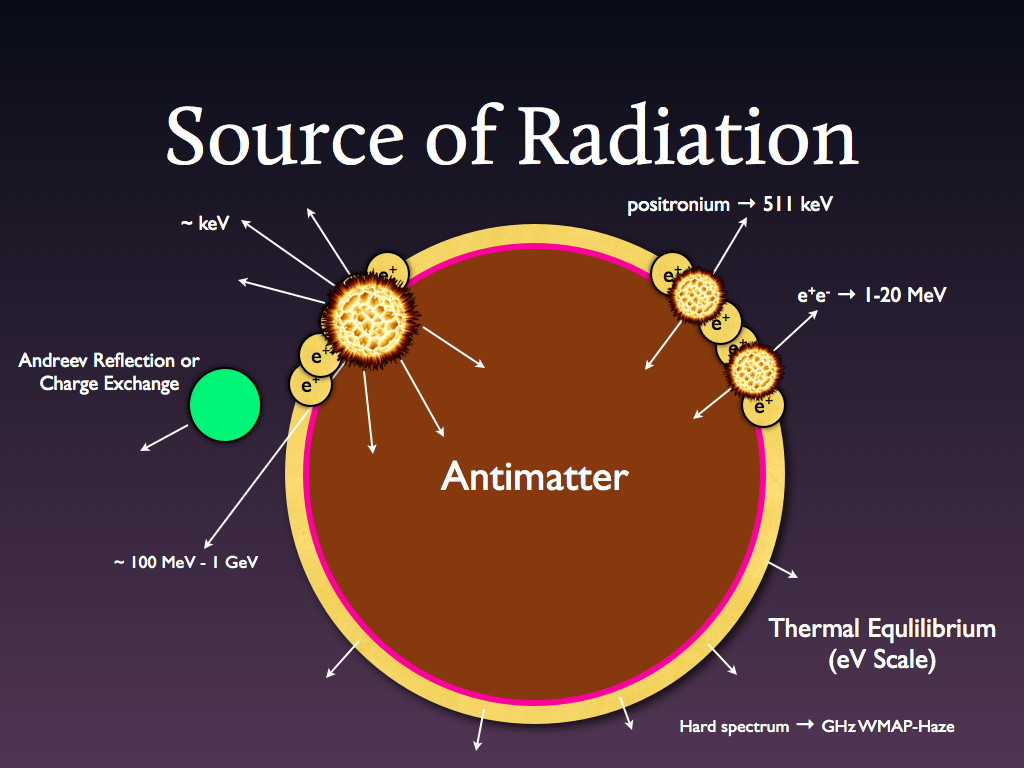
Quark Nuggets as Dark (anti)Matter¶
The Standard Model of cosmology is remarkably successful in quantitatively explaining almost all observations of our universe, yet it requires that over 95% of the material filling our universe behaves differently than regular matter we observe on earth.
Here we describe a proposal for explaining Dark Matter in terms of quark and anti-quark nuggets formed at the QCD phase transition. This proposal simultaneously solves the problems of baryogenesis and dark matter, naturally explaining the similar scales of dark and visible matter. Despite the proposal that most of the dark matter should interact strongly with visible matter, all emissions from the nuggets fit with known observational constraints, and can even explain outstanding astrophysical mysteries.
Table of Contents¶
Outline¶
- Dark Matter?
- Evidence:
- Rotation curves
- Structure formation
- Bullet cluster
- Nucleosynthesis
- CMB
- Baryon/entropy ratio
- What is Dark Matter?
- WIMPs
- Neutrinos
- Axions
- SUSY
- Machos
- Quark nuggets
- Modified gravity
- Extra dimensions
- Image of another universe
- WIMPs
- Other consequences
- WMAP Haze
- Emissions from galaxy core
- From clusters
- Direct detection
- Evidence:
- Baryogenesis.
What is Dark Matter? (The Two Standard Models of Physics)¶
Through our experiences on earth, we have discovered many different types of matter. At first it seems like the variety is boundless - from water, to air, metals, rocks, trees, etc. As our ability to analyze and break apart matter improved, we discovered that all of these materials could be decomposed into atoms formed from three components: protons, neutrons (called "baryons"), and electrons. The advent of particle accelerators allowed us to deduce that protons and neutrons were in turn were formed from quarks and gluons, and identified
This classification of particles – known as the Standard Model of particle physics – is one of the most accurate and successful scientific theory to date. All of its predictions, including the recent discovery of the Higgs particle, have so far been verified. Despite its astounding success, however, it is known to be incomplete. In particular, the portion of the theory describing electromagnetic interactions (quantum electrodynamics or QED) must break down at some scale due to the appearance of a Landau pole. The drive to understand how this portion of the theory is resolved, and the discovery of new particles, lies at the base of the efforts at CERN.
Complementing the Standard Model of particle physics, is the Standard Model of cosmology. This theory, based on a unification of the Big Bang theory, inflation, baryogenesis, and galaxy formation has also been accurately verified over an incredible range of scales, from the large scale structure of matter in our universe as determined by dedicated observational surveys Sloan digital sky surveye (SDS) to detailed features such as Doppler peaks (see 9511148) of the cosmic microwave background – the residual radiation left streaming throughout the universe from shortly after the Big Bang when the universe first become transparent to radiation. Thousands of observations across many orders of magnitude in scale all fit within this relatively simple framework, with no major deviations...
... except for one "small" detail. To realize this fantastically accurate and comprehensive description of the universe, the theory requires that more than 95% of the stuff in our universe be made of material that we have never seen or observed: dark matter and dark energy.
What Evidence is there for Dark Matter?¶
Galaxy Rotation Curves¶
Structure formation¶
Gravitational Lensing¶
Bullet cluster
Nucleosynthesis¶
Baryon/entropy ratio¶
Cosmic Microwave Background¶
Standard Model of Cosmology¶
So What Could Dark Matter Be?¶